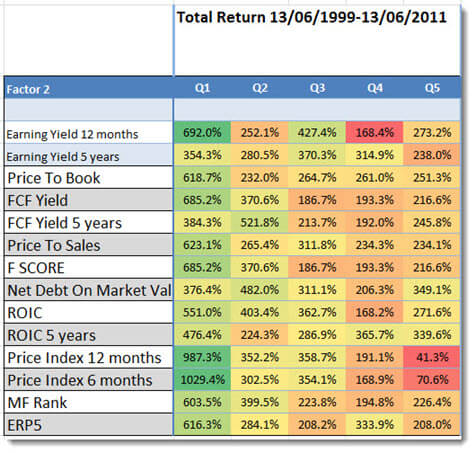Price to Book and 6m Momentum Investment strategy
The Price to Book ratio (Current share price / Book value per share) is a good valuation ratio you can use to find undervalued investment ideas.
It has been tested in numerous research papers, over long periods of time, and is an investment strategy that outperforms the market.
Before I show you the actual returns first some information on how we tested.
Methodology
We only use historical accounting data and no forecasts. The reason being is that there is ample evidence that forecasts cannot be relied on. For example, in his excellent book, ‘The New Contrarian Investment Strategy’, David Dreman mentioned a study that used a sample of 67.375 analysts' quarterly estimates for companies listed on US stock exchanges.
The study found that the average analysts’ error was 40%, and that the estimates were misleading two-third of the time!
The back test universe and benchmark
Our back test universe is a subset of companies in the Datastream database containing an average of about 1500 companies in the 17 country Eurozone market during our 12-year test period (13 June 1999 to 13 June 2011).
We excluded banks, insurance companies, investment funds, certain holdings companies, and REITS.
We included bankrupt companies to avoid any survivor bias. Bankrupt companies, or companies that were taken over, returns were calculated using the last stock market price available before the company was delisted.
We excluded companies with an average 30-day trading volume of less than €10 000.
It was not a good time to invest in stocks
The test period was most certainly not a good time to be invested in stocks.
The 12-year period we tested included a stock market bubble (1999), two recessions (2001, 2008-2009) and two bear markets (2001-2003, 2007-2009).
In spite of all the substantial movements it was essentially a sideways market, as Vitaliy Katsenelson defined in his book, ‘The Little Book of Sideways Markets’.
Holding periods and quintile tests
Each year all the portfolios we tested were formed (and re-balanced) on 16 June. We chose 16 June as most European companies have a December year-end and by this date all their previous year-end results would be available in the database.
The annual returns for our back test portfolios were calculated as the 12-month price change plus dividends received over the period. Returns were compounded on an annual basis.
This means each year the return of the portfolio (dividends included) would be reinvested (equally weighted) in the strategy the following year.
The portfolios were all constructed on an equal-weighted basis.
In order to test the effectiveness of a strategy, we divided our back test universe into five equal groups (quintiles), according to the factor we were testing. For example, when testing a low price-to-book (PB) value strategy, we ranked our back test universe from the cheapest (lowest PB) to the most expensive (highest PB) stocks.
The cheapest 20% of companies were put in the first quintile (Q1), the next in the second, and so on, with the 20 % of companies with the highest price-to-book value in the fifth quintile (Q5).
Price to book returns can be improved
But, as you have seen with other one ratio investment strategies, it can be substantially improved.
Before we get to that here are the back tested returns you could have earned if you used a low PB strategy to invest in Europe over the 12 year period 13 June 1999 to 13 June 2011.

Click image to enlarge
Source: Quantitative Value Investing in Europe: What works for achieving alpha
Q1 (Quintile 1) represents the cheapest 20% of companies in terms of PB and Q5 (quintile 5) the most expensive.
The lowest PB companies (Q1) substantially outperformed the market, which over the same 12 year period returned 30.54%.
As you can see the strategy worked best for medium sized companies.
But you can do a lot better
As mentioned you can improve your returns substantially if you combine Price to Book with another ratio or indicator as the table below clearly shows:

Click image to enlarge
Source: Quantitative Value Investing in Europe: What works for achieving alpha
Best combination – Momentum
The best way to increase your returns was to combine PB with Price Index 6 months (6 months momentum) or Price Index 12 months (12 months momentum).
Momentum beats the Piotroski F-Score
As you can see the combination of price to book with momentum did even better compared to using the Piotroski F-Score investment strategy (+685.2%).
Exact definitions – all in the glossary
You can see the exact definition of all the ratios and indicators in the Glossary.
Be careful! Price to Book has long periods of under-performance
Although the Price to Book ratio is a good valuation ratio it also has long periods of under-performance. To find out more take a look at the following article: Be careful of this time tested value ratio
Use Book to Market rather than Price to Book
When searching for low Price to Book companies it is better if you use the Book to Market ratio (the inverse of Price to Book) to see why read the following article: Why use book to market and not price to book?
Backtest Updated 2015 to 2022
We updated the backtest combining six months momentum (Price Index 6 months) with low price to book stocks here:
Momentum Meets Value: Europe's Stunning +1157.5% Strategy Updated!
PS To find investment ideas using a Price to Book and momentum investment strategy for your portfolio sign up here.
PPS It is so easy to put this off, why not sigh up right now before it slips your mind?

